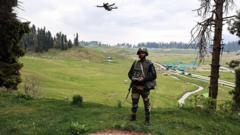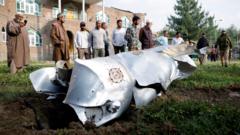As India and Pakistan enter a new chapter in military conflict utilizing drone technology, experts warn of the increased risk of escalation in the volatile region.**
Tensions Escalate Over New Era of Drone Warfare in India-Pakistan Conflict**

Tensions Escalate Over New Era of Drone Warfare in India-Pakistan Conflict**
The ongoing hostilities have marked a significant shift towards drone warfare in the long-standing rivalry.**
The landscape of the India-Pakistan conflict has transformed dramatically as the two nuclear-armed nations embrace drone warfare, marking what experts have dubbed the first drone war of the age. On Thursday, India accused Pakistan of launching a barrage of drones and missiles targeting military installations in Indian territory, a claim swiftly rebutted by Islamabad, which alleged it had intercepted and downed 25 Indian drones in recent hours.
The back-and-forth exchanges of drone attacks signal a perilous evolution in the protracted hostilities, moving beyond traditional artillery confrontations to unmanned aerial combat. Analysts suggest that the deployment of drones, which can operate silently and with deniability, introduces an unprecedented dynamic to the long-standing conflict.
“The current situation displays a shifting battlefield where unmanned systems can dictate strategies. The side that excels in drone warfare will not just observe the battlefield but will have the potential to redefine it,” remarked Jahara Matisek, a military analyst from the US Naval War College.
Reports indicate that since Wednesday, at least 36 individuals have died in Pakistan due to Indian shelling, while India's military confirmed 16 civilian casualties resulting from Pakistani strikes. Contextually, these operations have been framed by each country as retaliatory for a previous escalation, particularly following a militant attack in India that both sides officially deny responsibility for.
In the wake of these developments, the technological aspect of modernizing military capabilities has been thrust into the spotlight. India is known to operate various Israeli-made drones, such as the IAI Searcher and Heron, which serve dual roles for reconnaissance and precision strikes. The recent $4 billion deal to procure MQ-9B Predator drones from the United States further enhances these capabilities, expanding India's scope for targeted operations.
Conversely, Pakistan has cultivated an impressive fleet of drones derived from both indigenous development and international partnerships, including Turkish and Chinese systems. The use of loitering munitions has also become a part of Pakistan's military strategy, reflecting its ongoing arms race with India.
While drone technology offers significant advantages in warfare, experts are quick to warn that its implementation reflects a lower-tier military option; drones carry less firepower than conventional aircraft and may contribute to a more restrained response. However, strategists express concern that the current drone exchanges could be a precursor to more extensive aerial campaigns.
“The recent drone activity suggests tactical responses instead of a full-scale retaliatory strike. A significant operation would involve more diverse forces and higher stakes, escalating the situation significantly,” stated Ejaz Haider, a defense analyst from Lahore.
The current scenario emphasizes both the transformative potential of drone warfare on the battlefield and the delicate balance of military confrontation in South Asia. Although this technological shift aims to enable effective strikes while minimizing risk, it also introduces complex escalation dynamics. Each downed drone or blinded radar could act as a flashpoint, potentially igniting greater conflict between the two nations.
As the world watches closely, it remains to be seen whether the current military exchanges lead to further de-escalation or if they are merely the prelude to a larger confrontation. The future trajectory of drone warfare in this region is fraught with uncertainty, signaling an era that could reshape the conflict as India and Pakistan navigate their fraught relationship under the increasing specter of unmanned combat.


















